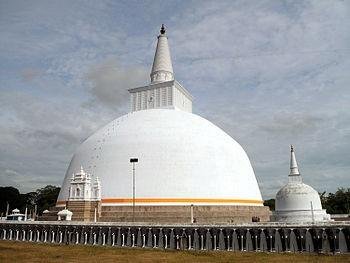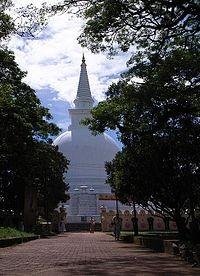Ancient stupas of Sri Lanka


Stupas, also called dagobas and cetiyas, are considered an outstanding type of architectural creation of ancient Sri Lanka. Under the influence of Buddhism, there were several changes in the field of architecture in Sri Lanka. The stupa commands a prominent place among these changes. The Stupa is also known by synonymous names such as Chaithya, Dagaba, Thupa, Seya and Vehera.[1] Stupas designed and constructed in Sri Lanka are the largest brick structures known to the pre-modern world.[2]
After Mahinda introduced Buddhism during the reign of King Devanampiya Tissa of Anuradhapura(307-267 BCE), in the Sri Lanka’s ancient sacred capital of Anuradhapura, the king built theAnuradhapura Maha Viharaya, a mahavihara, after dedicating the Nandana and Mahamega royal pleasure gardens to the Maha Sangha. The earliest monument found in Sri Lanka is the Stupa, which is described as a hemispherical dome surmounted with a spire (kota).
Mahiyangana Raja Maha Vihara in Mahiyangana,Uva Province is regarded as the first stupa of ancient Sri Lanka[3]The first historical stupa constructed after the arrival of Mahinda in Sri Lanka is Thuparamaya, which was built during the reign of King Devanampiya Tissa.[4] Afterwards many stupas were built, some colossal stupas, biggest of which is Jetavanaramaya.


There are two recorded instances regarding the construction of stupas in Sri Lanka in the lifetime of Gautama Buddha. One of those instances is the construction of the cetiya at Mahiyangana Raja Maha Vihara at Mahiyangana in the valley of Mahaweli, which enshrines the Buddha's Hair Relic reputedly presented by the Buddha to Saman, adeva.The other instance is the construction of a stupa at Tiriyaya enshrining the Hair Relics presented to the tradesman brothers Tapassu and Balluka. This event is mentioned in an inscription written in Sanskrit found at this site.[1]
During the time of Ashoka, numerous ‘stupas’ were built at hallowed sites in India. In these were enshrined relics of the Buddha which people venerated. When it was observed that there were no Buddha relics in Sri Lanka, the king, at Mahinda’s suggestion, appealed to Emperor Asoka to send some relics. He responded to the king’s request and sent the right collarbone relic of the Buddha. King Devanam Piya Tissa built the Thuparamaya to enshrine this relic, the right collarbone of the Buddha. The Thuparamaya is regarded as the first ever historical stupa built in Sri Lanka. The building of colossal stupas started during the reign of King Dutugamunu. Afterward many kings built stupas.
Ancient stupas tell us about the pride and the great civilization that we had enriched with Buddhism.
Downvoting a post can decrease pending rewards and make it less visible. Common reasons:
Submit
Hi! I am a robot. I just upvoted you! I found similar content that readers might be interested in:
https://www.revolvy.com/main/index.php?s=Ancient%20stupas%20of%20Sri%20Lanka&item_type=topic&sr=50
Downvoting a post can decrease pending rewards and make it less visible. Common reasons:
Submit